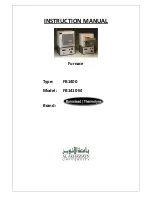
40
Resetting From Lockout
Furnace lockout results when a furnace is unable to achieve
ignition after three attempts during a single call for heat. It is
characterized by a non-functioning furnace and a fault code
displayed. If the furnace is in “lockout”, it will (or can be) reset
in any of the following ways.
1. Automatic reset. The integrated control module will
automatically reset itself and attempt to resume normal
operations following a one hour lockout period.
2. Manual power interruption. Interrupt 115 volt power to
the furnace.
3. Manual thermostat cycle. Lower the thermostat so that
there is no longer a call for heat for 1 -20 seconds then
reset to previous setting.
NOTE:
If the condition which originally caused the lockout
still exists, the control will return to lockout. Refer to the
Troubleshooting Chart
for aid in determining the cause.
Maintenance
Annual Inspection
The furnace should be inspected by a qualified installer, or
service agency at least once per year. This check should be per-
formed at the beginning of the heating season. This will ensure
that all furnace components are in proper working order and
that the heating system functions appropriately. Pay particular
attention to the following items. Repair or service as necessary.
•
Flue pipe system. Check for blockage and/or leakage.
Check the outside termination and the connections at
and internal to the furnace.
• Heat exchanger. Check for corrosion and/or buildup
within the heat exchanger passageways.
• Burners. Check for proper ignition, burner flame, and
flame sense.
•
Drainage system. Check for blockage and/or leakage.
Check hose connections at and internal to furnace.
• Wiring. Check electrical connections for tightness and/
or corrosion. Check wires for damage.
• Filters.
Filters
Filter Maintenance
Improper filter maintenance is the most common cause of
inadequate heating or cooling performance. Filters should be
cleaned (permanent) or replaced (disposable) every two months
or as required. When replacing a filter, it must be replaced
with a filter of the same type and size.
Filter Removal
Depending on the installation, differing filter arrangements can
be applied. Filters can be installed in either the central return
register or a side panel external filter rack (upflow only). A
media air filter or electronic air cleaner can be used as an al
-
ternate filter. Follow the filter sizes given in the Recommended
Minimum Filter size table to ensure proper unit performance.
To remove filters from an external filter rack in an upright up
-
flow installation, follow the directions provided with external
filter rack kit.
Horizontal Unit Filter Removal
Filters in horizontal installations are located in the central return
register or the ductwork near the furnace.
To remove:
1. Turn OFF electrical power to furnace.
2. Remove filter(s) from the central return register or
ductwork.
3. Replace filter(s) by reversing the procedure for removal.
4. Turn ON electrical power to furnace.
Media Air Filter or Electronic Air Cleaner Removal
Follow the manufacturer’s directions for service.
Burners
Visually inspect the burner flames periodically during the heating
season. Turn on the furnace at the thermostat and allow several
minutes for flames to stabilize, since any dislodged dust will
alter the flames normal appearance. Flames should be stable,
quiet, soft, and blue (dust may cause orange tips but they must
not be yellow). They should extend directly outward from the
burners without curling, floating, or lifting off. Flames must
not impinge on the sides of the heat exchanger firing tubes.
Induced Draft and Circulator Blowers
The bearings in the induced draft blower and circulator blow-
er motors are permanently lubricated by the manufacturer.
No further lubrication is required. Check motor windings for
accumulation of dust which may cause overheating. Clean as
necessary.
Burner Flame
Figure 41
















































